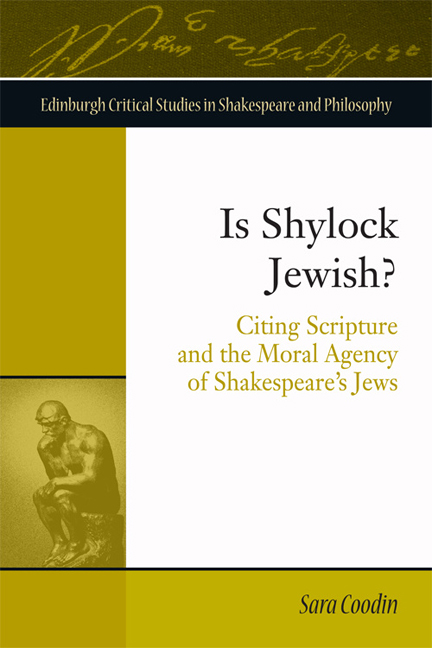2 - Parti-Coloured Parables
Published online by Cambridge University Press: 22 December 2017
Summary
Catalysed by the Protestant return to the original texts of the Bible, the sixteenth century saw a sharp rise in the study of the Jewish Bible and the Hebrew language by Christians. Engagement with the Torah along with its oral and written commentaries in this period exposed to view the vast array of historical and cultural-linguistic strata that underwrote both New and Old Christian Testaments. The multivocality of biblical writings was made graphically evident in the progressively elaborate multi-language bibles produced in this period, the most baroque of which was the London Polyglot published in 1657 featuring nine different language-texts on every folio page. The multi-vocal potential of biblical texts is something to which Shakespeare's dramatic writings also keenly attuned. In act 1, scene 3 of The Merchant of Venice, Antonio and Shylock begin to negotiate their loan, and Shylock recounts a story from the Book of Genesis featuring Jacob's unlikely success breeding his uncle's livestock.
When Laban and himself were compromised
That all the eanlings which were streaked and pied
Should fall as Jacob's hire, the ewes being rank
In end of autumn turned to the rams,
And when the work of generation was
Between those woolly breeders in the act,
The skillful shepherd peeled me certain wands,
And in the doing of the deed of kind
He stuck them up before the fulsome ewes,
Who then conceiving did in eaning time
Fall parti-coloured lambs, and those were Jacob's.
(1.3.75–85)Shylock's account of Jacob breeding Laban's ‘parti-coloured lambs’ sparks a dispute with Antonio that stands as the only instance of biblical-exegetical debate to appear anywhere in Shakespeare's dramatic writing. But debate is perhaps too strong a word for what happens in this episode, since Antonio clearly does not view this as much of a contest. In response to Shylock's lengthy deliberation, Antonio determines that the meaning of the biblical story is clear enough and singular.
- Type
- Chapter
- Information
- Is Shylock Jewish?Citing Scripture and the Moral Agency of Shakespeare's Jews, pp. 85 - 139Publisher: Edinburgh University PressPrint publication year: 2017



